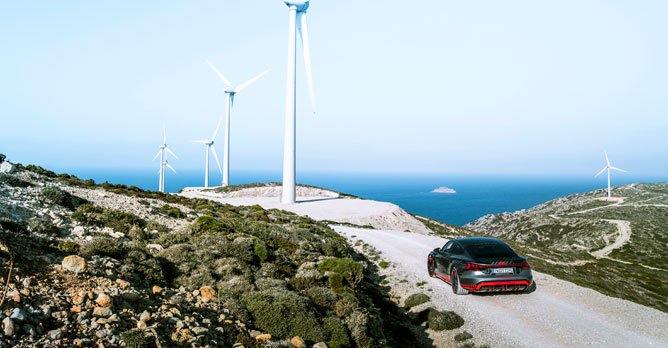The Audi e-tron GT enters series production
11 Dec 2020|1,406 views
At the Bollinger Hofe, passion meets precision, innovation and sustainability, with series production of the fully electric-powered Audi e-tron GT getting underway there.
High performance and environmental awareness go hand-in-hand - with 100% eco-electricity and heat from regenerative sources, production is net carbon-neutral. The resource-conserving vehicle production process also avoids paper and packaging, uses aluminium and polymer closed loops, and in a first for a new Audi model was planned without any physical prototypes at all.
Series production of the e-tron GT, Audi's most powerful electric vehicle, is launching at the Neckarsulm site. The production process at the Audi Bollinger Hofe is every bit as unique as the car itself. No vehicle bearing the four rings has ever been readied for series production as quickly.
It's not just the e-tron GT's drive concept that is sustainable, the entire production process at the Bollinger Hofe is net carbon-neutral. In early 2020, the entire Neckarsulm site began using exclusively eco-electricity. A combined heat-and-power plant fired with biogas provides the heat required for production at the Bolllinger Hofe.
The Mission:Zero environmental program comprises a variety of measures in production and logistics to effectively and sustainably reduce the ecological footprint. Focal points include decarbonisation, resource efficiency, biodiversity and innovation solutions for using water.
On the path toward carbon-neutral production, Audi is taking a consistent approach and considering the entire value chain. All of the rail traffic at the Neckarsulm site is climate neutral. A variety of locomotives with compressed natural gas or electric drives are used for shunting between the trailer yard and the plant grounds.
At the initiative of Audi experts, a key carrier also uses trucks powered with biomethane for the road transport of its shipments. And, two trucks powered with LNG are already being used to deliver parts to the site over longer distances. Another is to be added to the fleet by the end of the year. Each of them reduces emissions of CO2 by up to 20% and nitrogen oxides by approximately 85% compared with conventional diesel trucks.
Important resources are also being conserved and raw materials recycled at the site, too. The best example of this is the 'Aluminium Closed Loop.' This refers to a closed recycling chain for aluminium sheet offcuts produced in the press shop at the Neckarsulm site, such as during manufacture of the sidewall frame for the Audi e-tron GT.
With an extreme drawing depth of 35cm between the highest and lowest point, it is responsible for the pronounced shoulders above the wheel arches and thus forms the extremely distinctive quattro blisters of the e-tron GT.
Every last technical possibility in the demanding processing of aluminium is tapped to do this. Thanks to the Aluminium Closed Loop, the site saves several thousand metric tons of CO2 emissions each year by returning homogeneous aluminium sheet offcuts to the supplier, where they are recycled and ultimately reused at Audi.
The closed loops are not the only approaches to conserve raw materials. The e-tron GT is the first Audi whose production was planned without the use of any physical prototypes. All assembly sequences were tested virtually using software developed in-house and reality applications, and are now being used successfully in practice in series production.
Some of the special containers for the transport of sensitive parts were also planned without prototypes using the new virtual method. This saves metal, but also packaging to protect the parts. Keywords, waste and paper avoidance. The body shop and assembly are already largely paper free.
At the Bollinger Hofe, passion meets precision, innovation and sustainability, with series production of the fully electric-powered Audi e-tron GT getting underway there.
High performance and environmental awareness go hand-in-hand - with 100% eco-electricity and heat from regenerative sources, production is net carbon-neutral. The resource-conserving vehicle production process also avoids paper and packaging, uses aluminium and polymer closed loops, and in a first for a new Audi model was planned without any physical prototypes at all.
Series production of the e-tron GT, Audi's most powerful electric vehicle, is launching at the Neckarsulm site. The production process at the Audi Bollinger Hofe is every bit as unique as the car itself. No vehicle bearing the four rings has ever been readied for series production as quickly.
It's not just the e-tron GT's drive concept that is sustainable, the entire production process at the Bollinger Hofe is net carbon-neutral. In early 2020, the entire Neckarsulm site began using exclusively eco-electricity. A combined heat-and-power plant fired with biogas provides the heat required for production at the Bolllinger Hofe.
The Mission:Zero environmental program comprises a variety of measures in production and logistics to effectively and sustainably reduce the ecological footprint. Focal points include decarbonisation, resource efficiency, biodiversity and innovation solutions for using water.
On the path toward carbon-neutral production, Audi is taking a consistent approach and considering the entire value chain. All of the rail traffic at the Neckarsulm site is climate neutral. A variety of locomotives with compressed natural gas or electric drives are used for shunting between the trailer yard and the plant grounds.
At the initiative of Audi experts, a key carrier also uses trucks powered with biomethane for the road transport of its shipments. And, two trucks powered with LNG are already being used to deliver parts to the site over longer distances. Another is to be added to the fleet by the end of the year. Each of them reduces emissions of CO2 by up to 20% and nitrogen oxides by approximately 85% compared with conventional diesel trucks.
Important resources are also being conserved and raw materials recycled at the site, too. The best example of this is the 'Aluminium Closed Loop.' This refers to a closed recycling chain for aluminium sheet offcuts produced in the press shop at the Neckarsulm site, such as during manufacture of the sidewall frame for the Audi e-tron GT.
With an extreme drawing depth of 35cm between the highest and lowest point, it is responsible for the pronounced shoulders above the wheel arches and thus forms the extremely distinctive quattro blisters of the e-tron GT.
Every last technical possibility in the demanding processing of aluminium is tapped to do this. Thanks to the Aluminium Closed Loop, the site saves several thousand metric tons of CO2 emissions each year by returning homogeneous aluminium sheet offcuts to the supplier, where they are recycled and ultimately reused at Audi.
The closed loops are not the only approaches to conserve raw materials. The e-tron GT is the first Audi whose production was planned without the use of any physical prototypes. All assembly sequences were tested virtually using software developed in-house and reality applications, and are now being used successfully in practice in series production.
Some of the special containers for the transport of sensitive parts were also planned without prototypes using the new virtual method. This saves metal, but also packaging to protect the parts. Keywords, waste and paper avoidance. The body shop and assembly are already largely paper free.
Latest COE Prices
May 2025 | 2nd BIDDING
NEXT TENDER: 04 Jun 2025
CAT A$102,501
CAT B$116,988
CAT C$63,189
CAT E$118,010
View Full Results Thank You For Your Subscription.























